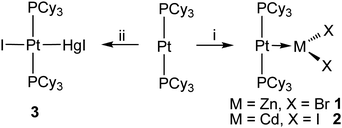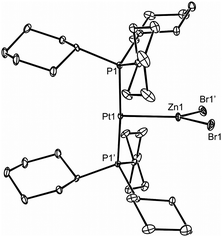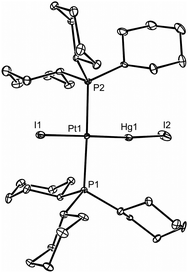Metal-only Lewis pairs featuring unsupported Pt→M (M = Zn or Cd) dative bonds†
Mengtao
Ma‡
,
Anastas
Sidiropoulos
,
Lalrempuia
Ralte
,
Andreas
Stasch
* and
Cameron
Jones
*
School of Chemistry, Monash University, PO Box 23, Melbourne, VIC 3800, Australia. E-mail: cameron.jones@monash.edu; andreas.stasch@monash.edu; Fax: +61-3-9905-4597; Tel: +61-3-9902-0391
First published on 5th November 2012
Abstract
Reactions of [Pt(PCy3)2] (Cy = cyclohexyl) with group 12 metal dihalides have afforded the novel metal only Lewis pair (MOLP) complexes, [(Cy3P)2Pt→MX2] (M = Zn or Cd, X = Br or I), or the oxidative addition product, trans-[(Cy3P)2(I)PtHgI]. The zinc complex represents the first MOLP to contain an unsupported Pt→Zn linkage.
The chemistry of heterobimetallic complexes featuring metal–metal bonds is of considerable importance, both for fundamental reasons, and because such systems have found a variety of applications in synthesis, catalysis, materials chemistry etc.1 While the majority of such compounds are stabilised by ligands that bridge their metal–metal bonds, compounds with unsupported metal–metal bonds are generally considered as being more reactive species.1,2 There are a variety of methodologies available for the construction of metal–metal bonded complexes, though the formation of heteronuclear M→M′ dative linkages from Lewis basic and Lewis acidic metal fragments is increasingly employed in this field.3 The popularity of this synthetic approach is derived from its simplicity, but also from the wide array of supported and unsupported M→M′ combinations that it offers the synthetic chemist. Compounds bearing such bonds have been termed metal-only Lewis pairs, or MOLPs.3a
One of the more important metal donor Lewis bases that have been examined in recent years is the linear platinum(0) complex, [Pt(PCy3)2] (Cy = cyclohexyl). This has been employed to great effect, largely by Braunschweig and co-workers, in the formation of novel complexes with unsupported dative bonds between platinum and an array of s-,4 p-5 and d-block6 metal fragments.5b,7 Structural and computational studies of several of these adducts have indicated that [Pt(PCy3)2] can act as a relatively strong Lewis base. Moreover, the oxidative addition of metal and non-metal halide bonds to its Pt0 centre has been demonstrated in some instances.5b,7 It is surprising that there have been no reports of adducts between [Pt(PCy3)2] and group 12 metal halides, and to the best of our knowledge, unsupported Pt→Zn MOLPs of any kind are unknown. Here we report the preparation of the thermally stable complexes, [(Cy3P)2Pt→MX2] (M = Zn or Cd; X = Br or I), and show that related mercury halide adducts are not easily accessible.
Treatment of toluene solutions of [Pt(PCy3)2] with either ZnBr2 or CdI2 led to high isolated yields of the yellow-orange crystalline products, 1 and 2, upon work-up (Scheme 1). Both compounds are thermally robust and show no tendency to convert to oxidative addition products, [(Cy3P)2(X)PtMX2], in solution or the solid state at ambient temperature. In contrast, treatment of [Pt(PCy3)2] with HgI2 afforded a high yield of the yellow addition product, trans-[(Cy3P)2(I)PtHgI] 3, with no evidence of adduct formation (though the reaction likely proceeds via [(Cy3P)2Pt→HgI2]). Similar oxidative addition processes have been previously described for reactions of [Pt(PCy3)2] with, for example, GaX3 (X = Br or I), BiCl3 and group 11 metal halides.5b,7 However, the outcome of these reactions can be dependent on the nature of the halide as much as the metal, as evidenced by the fact that GaCl3 forms a stable adduct with the Pt0 Lewis base.5b As a result, we investigated the reaction of HgCl2 with [Pt(PCy3)2], and found that this led to deposition of mercury metal and the formation of the known complex, trans-[PtCl2(PCy3)2],8 in addition to small amounts of trans-[(Cy3P)2(Cl)PtHgCl] (see ESI†). It is noteworthy that a similar result was obtained from the reaction of Hg2Cl2 with [Pt(PCy3)2].
 | ||
| Scheme 1 Reagents and conditions: i, ZnBr2 or CdI2; ii, HgI2 (Cy = cyclohexyl). | ||
The NMR spectroscopic data for 1 and 2 are similar and suggest both retain their solid state structures in solution.§ Their 31P{1H} NMR spectra display singlet resonances at δ = 53.0 and 51.6 ppm respectively, each of which exhibits 195Pt satellites (1JPtP = 2982 Hz 1; 2978 Hz 2). These values are comparable to those for the isostructural adduct, [(Cy3P)2Pt→BeCl2] (δ = 53.6 ppm, 1JPtP = 3240 Hz),4 but lower in magnitude than the values for the precursor complex, [Pt(PCy3)2] (δ = 62.2 ppm, 1JPtP = 4155 Hz).7a Furthermore, 111/113Cd satellites (2JCdP = 36 Hz) flank the signal for 2. Triplet resonances were observed in the 195Pt{1H} NMR spectra of the compounds (1: δ = −5425 ppm, 2: δ = −5260 ppm), which are significantly downfield of that for [Pt(PCy3)2] (δ = −6505 ppm).7a The NMR spectroscopic data for the insertion product 3 (31P{1H}: δ = 31.0 ppm, 1JPtP = 2448 Hz, 2JHgP = 299 Hz; 195Pt{1H}: δ = −5052 ppm) compare well with data for similar compounds, e.g. trans-[(Cy3P)2(I)PtGaI2] (31P{1H}: δ = 23.1 ppm, 1JPtP = 2281 Hz).5b
X-ray crystallographic studies determined 1 and 2 to be monomeric and isostructural in the solid state. Therefore only the molecular structure of 1 is depicted in Fig. 1 (see ESI† for an ORTEP diagram of 2).¶ Both compounds are also broadly isostructural with [(Cy3P)2Pt→BeCl2] in that their Lewis acidic metal centres all possess trigonal planar geometries, while their Pt centres have T-shaped coordination environments with close to linear P–Pt–P fragments. In fact, this unit in 1 and 2 is more obtuse than in any other metal adduct of [Pt(PCy3)2]. The PtMX2 and P2PtM least squares planes of 1 and 2 bisect each other at angles of 71.8° 1 and 69.7° 2 (cf. 71.8° in [(Cy3P)2Pt→BeCl2]4). With regard to the Pt–M distances in the compounds, that in 1 (2.4040(6) Å) is at the short end of the known range (2.343–3.003 Å),9 with only covalently bonded two-coordinate zinc compounds, e.g. [Cp*Pt(ZnCp*)3],10 having shorter Pt–Zn bonds. Furthermore, the Pt–Cd bond in 2 (2.5867(6) Å) is shorter than all of the more than 50 other reported examples of such interactions (range: 2.606–3.129 Å).9 This, combined with the fact that 1 and 2 possess very rare examples of terminal MX2 fragments, could indicate that [Pt(PCy3)2] acts as a strong nucleophile to those fragments.11
 | ||
| Fig. 1 Molecular structure of 1 (25% thermal ellipsoids; hydrogen atoms omitted). Selected bond lengths (Å) and angles (°) for 1: Pt(1)–P(1) 2.2760(6), Pt(1)–Zn(1) 2.4040(6), Br(1)–Zn(1) 2.3305(5), P(1)′–Pt(1)–P(1) 176.28(3), Br(1)–Zn(1)–Br(1)′ 118.75(3), Br(1)–Zn(1)–Pt(1) 120.626(15), Br(1)′–Zn(1)–Pt(1) 120.626(15); symmetry operation: ′−x + 1, y, −z + 1/2. Selected bond lengths (Å) and angles (°) for 2 (see ESI† for ORTEP diagram): Pt(1)–P(1) 2.2799(13), Pt(1)–P(2) 2.2920(13), Pt(1)–Cd(1) 2.5867(6), I(1)–Cd(1) 2.6974(8), I(2)–Cd(1) 2.6997(8), P(1)–Pt(1)–P(2) 176.92(3), Pt(1)–Cd(1)–I(1) 122.176(19), Pt(1)–Cd(1)–I(2) 117.531(19), I(1)–Cd(1)–I(2) 120.21(2). | ||
The molecular structure of 3 (Fig. 2) confirms it to be an oxidative addition product. The compound is monomeric and its Pt center has a square planar coordination environment, with the two phosphine ligands trans- to each other. The Pt–Hg bond length is at the low end of the reported range for unsupported interactions of this nature (2.509–2.808 Å),9 while the terminal Hg–I and Pt–I distances are unexceptional. It is of note that several reports have detailed the oxidative addition of mercury(II) dihalides to platinum(II) centres,12 though we are not aware of any prior structurally authenticated examples of such additions to platinum(0) complexes.
 | ||
| Fig. 2 Molecular structure of 3 (25% thermal ellipsoids; hydrogen atoms omitted). Selected bond lengths (Å) and angles (°): Hg(1)–Pt(1) 2.5250(2), Hg(1)–I(2) 2.6764(16), Pt(1)–P(1) 2.3304(10), Pt(1)–P(2) 2.3403(10), Pt(1)–I(1) 2.6542(3), Pt(1)–Hg(1)–I(2) 173.05(3), P(1)–Pt(1)–P(2) 168.10(4), Hg(1)–Pt(1)–I(1) 178.850(11), P(1)–Pt(1)–Hg(1) 85.99(2), P(2)–Pt(1)–Hg(1) 87.17(3). | ||
In conclusion, the first examples of adducts between the widely used metal donor Lewis base, [Pt(PCy3)2], and group 12 metal fragments have been prepared and structurally characterised. One synthesised complex, [(Cy3P)2Pt→ZnBr2], represents the first MOLP containing an unsupported Pt→Zn linkage, while attempts to prepare a related Pt→Hg adduct, instead lead to an oxidative addition reaction. We are currently exploring the controlled reduction of 1–3 and related compounds with the aim of forming well defined, low valent bimetallic cluster compounds. Our results in this direction will be reported in due course.
CJ and AS gratefully acknowledge financial support from the Australian Research Council (fellowships for MM and LR). The EPSRC is also thanked for access to the UK National Mass Spectrometry Facility.
Notes and references
- See for example: (a) C. M. Thomas, Comments Inorg. Chem., 2011, 32, 14 CrossRef CAS; (b) M. Asay, C. Jones and M. Driess, Chem. Rev., 2011, 111, 354 CrossRef CAS; (c) S. T. Liddle and D. P. Mills, Dalton Trans., 2009, 5592 RSC; (d) L. Gade, Angew. Chem. Int. Ed., 2000, 39, 2658 CrossRef CAS; (e) N. Wheatley and P. Kalck, Chem. Rev., 1999, 99, 3379 CrossRef CAS; (f) D. W. Stephan, Coord. Chem. Rev., 1989, 95, 41 CrossRef CAS , and references therein.
- See for example: H. Lei, J.-D. Guo, J. C. Fettinger, S. Nagase and P. P. Power, J. Am. Chem. Soc., 2010, 132, 17399 Search PubMed , and references therein.
- See for example: (a) J. Bauer, H. Braunschweig and R. D. Dewhurst, Chem. Rev., 2012, 112, 4329 CrossRef CAS; (b) A. Amgoune and D. Bourissou, Chem. Commun., 2011, 47, 859 RSC , and references therein.
- H. Braunschweig, K. Gruss and K. Radacki, Angew. Chem. Int. Ed., 2009, 48, 4239 CrossRef CAS.
- See for example: (a) H. Braunschweig, A. Damme, R. D. Dewhurst, F. Hupp, J. O. C. Jiminez-Halla and K. Radacki, Chem. Commun., 2012, 48, 10410 RSC; (b) H. Braunschweig, K. Gruss and K. Radacki, Inorg. Chem., 2008, 47, 8595 CrossRef CAS; (c) H. Braunschweig, K. Gruss and K. Radacki, Angew. Chem. Int. Ed., 2007, 46, 7782 CrossRef CAS.
- H. Braunschweig, K. Radacki and K. Schwab, Chem. Commun., 2010, 46, 913 RSC.
- See for example: (a) J. Bauer, H. Braunschweig, A. Damme and K. Radacki, Angew. Chem. Int. Ed., 2012, 51, 10030 Search PubMed; (b) J. Bauer, H. Braunschweig, K. Kraft and K. Radacki, Angew. Chem. Int. Ed., 2011, 50, 10457 CrossRef; (c) H. Braunschweig, P. Brenner, P. Cogswell, K. Kraft and K. Schwab, Chem. Commun., 2010, 46, 7894 RSC.
- A. Del Pra and G. Zanotti, Inorg. Chim. Acta, 1980, 39, 137 CrossRef CAS.
- As determined from a survey of the Cambridge Crystallographic Database, October, 2012.
- T. Bollermann, K. Freitag, C. Gemel, R. W. Seidel and R. A. Fischer, Organometallics, 2011, 30, 4123 CrossRef CAS , and references therein.
- N.B. In order to draw structural comparisons with other adducts between sterically bulky and strongly nucleophilic Lewis bases and the ZnBr2 and CdI2 fragments, the N-heterocyclic carbene, IPr (:C{N(Dip)C(H)}2, Dip = C6H3Pri2-2,6), was reacted with the metal halides. However, instead of monomeric adducts, the dimeric, halide bridged complexes, [{(IPr)MX(μ-X)}2] (M = Zn or Cd, X = Br or I), were formed, thus discounting the proposed comparisons. See ESI† for synthetic, spectroscopic and structural details of these adducts.
- See for example: (a) M. C. Janzen, M. C. Jennings and R. J. Puddephatt, Inorg. Chim. Acta, 2005, 358, 1614 Search PubMed; (b) M. C. Janzen, M. C. Jennings and R. J. Puddephatt, Inorg. Chem., 2001, 40, 1728 CrossRef CAS.
Footnotes |
| † Electronic supplementary information (ESI) available: Further details and references for synthetic and crystallographic studies. CCDC 905516–905520. For ESI and crystallographic data in CIF or other electronic format see DOI: 10.1039/c2cc37442k |
| ‡ Current address: Department of Chemistry, College of Science, Nanjing Forestry University, Jiangsu 210037, China. |
| § [(Cy3P)2Pt→ZnBr2] (1): ZnBr2 (0.039 g, 0.173 mmol) was added to a solution of [Pt(PCy3)2] (0.131 g, 0.173 mmol) in toluene (80 cm3) at −70 °C. The mixture was warmed to room temperature overnight, then concentrated to ca. 25 cm3in vacuo. Yellow-orange crystals of 1 deposited from this solution over 1 week (0.14 g, 0.143 mmol, 83%). N.B. Crystals for the X-ray experiment were grown from benzene. M.p. 258–260 °C; 1H NMR (300 MHz, 303 K, C6D6): δ = 1.29 (br., 18H, Cy-CH2), 1.60–1.73 (m, 30H, Cy-CH2), 2.06–2.12 (m, 12H, Cy-CH2), 2.28 (m, 6H, Cy-CH); 13C{1H} NMR (75.5 MHz, 303 K, C6D6): δ = 26.4 (s, C4, Cy), 27.6 (virtual triplet, JPC = 11 Hz, C2,6, Cy), 31.6 (s, C3,5, Cy), 35.7 (virtual t, JPC = 27 Hz, C1, Cy); 31P{1H} NMR (121.5 MHz, 303 K, C6D6): δ = 53.0 (s, 1JPt-P = 2982 Hz); 195Pt{1H} NMR (85.6 MHz, 300 K, C6D6): δ = −5425 (s, 1JPt-P = 2980 Hz); IR (Nujol) ν (cm−1): 1601s, 1006s, 889s, 851s, 814s, 748s, 698s; MS (−ve CI/CH4) m/z (%): 981.2 (M−, 6), 898.0 (M−-Br, 1); anal. calcd for C36H66Br2P2PtZn: C 44.07%, H 6.78%; found: C 44.10%, H 6.87%. [(Cy3P)2Pt→CdI2] (2): A similar procedure to that used to prepare 1 was employed for the synthesis of 2 (yield: 74%). M.p. 229–231 °C; 1H NMR (300 MHz, 303 K, C6D6): δ = 1.30 (br., 18H, Cy-CH2), 1.61–1.74 (m, 30H, −CH2), 2.06 (m, 12H, −CH2), 2.22 (m, 6H, −CH); 13C{1H} NMR (75.5 MHz, 303 K, C6D6): δ = 26.4 (s, C4, Cy), 27.7 (virtual t, JPC = 11 Hz, C2,6, Cy), 31.8 (s, C3,5, Cy), 36.0 (virtual t, JPC = 27 Hz, C1, Cy); 31P{1H} NMR (121.5 MHz, 303 K, C6D6): δ = 51.6 (s, 1JPt-P = 2978 Hz, 2JCd-P = 36 Hz); 195Pt{1H} NMR (85.6 MHz, 300 K, C6D6): δ = −5260 (s, 1JPt-P = 2974 Hz); IR (Nujol) ν (cm−1): 1494w, 1027s, 914m, 887m, 851m, 799s, 732s, 695m; MS (−ve CI/CH4) m/z (%): 1122.1 (M−, 1), 754.3 (M−-CdI2, 1), 367.6 (CdI2−, 2); anal. calcd for C36H66CdI2P2Pt: C 38.53%, H 5.93%; found: C 38.42%, H 5.90%. trans-[(Cy3P)2(I)PtHgI] (3): HgI2 (0.101 g, 0.222 mmol) was added to a solution of [Pt(PCy3)2] (0.167 g, 0.221 mmol) in toluene (20 cm3) at −65 °C. The mixture was warmed to room temperature over 2 h, then concentrated to ca. 8 cm3in vacuo. Hexane (20 cm3) was added to this solution and the mixture allowed to stand in the absence of light for 1 day, yielding yellow crystals of 3 (0.24 g, 0.198 mmol, 90%). M.p. 270–272 °C; 1H NMR (300 MHz, 303 K, C6D6): δ = 1.22 (m, 6H, Cy-CH2), 1.37 (m, 12H, Cy-CH2), 1.60–1.73 (m, 30H, Cy-CH2), 2.14 (d, 12H, Cy-CH2), 2.89 (br., 6H, Cy-CH); 13C{1H} NMR (75.5 MHz, 303 K, C6D6): δ = 26.9 (s, C4, Cy), 27.7 (virtual t, JPC = 11 Hz, C2,6, Cy), 31.1 (virtual t, JPC = 22 Hz, C3,5, Cy), 39.0 (virtual t, JPC = 29 Hz, C1, Cy). 31P{1H} NMR (121.5 MHz, 303 K, C6D6): δ = 31.0 (s, 1JPt-P = 2448 Hz, 2JHg-P = 299 Hz); 195Pt{1H} NMR (85.6 MHz, 300 K, C6D6): δ = −5052 (s, 1JPt-P = 2446 Hz); IR (Nujol) ν (cm−1): 1445s, 1050m, 1002s, 916m, 891s, 848s, 816m, 733s; MS (EI/70 eV) m/z (%): 1082.3 (M+-I, 1), 755.4 (M+-HgI2, 75); anal. calcd for C36H66HgI2P2Pt: C 35.72%, H 5.50%; found: C 35.63%, H 5.38%. |
¶ Crystal data for 1·(benzene): C42H72Br2P2PtZn, M = 1059.22, monoclinic, space group C2/c, a = 16.7915(8) Å, b = 10.9089(17) Å, c = 23.5671(14) Å, β = 93.615(5)°, V = 4308.4(7) Å3, Z = 4, Dc = 1.633 g cm−3, F(000) = 2128, μ(Mo-Kα) = 5.757 mm−1, 123(2) K, 19036 collected reflections, 6274 unique reflections [R(int) 0.0240], R (on F) 0.0251 (I > 2σI), wR (on F2) 0.0523 (all data); Crystal data for 2·(toluene): C43H74CdI2P2PtZn, M = 1214.25, monoclinic, space group C/c, a = 17.011(3) Å, b = 11.399(2) Å, c = 23.647(5) Å, β = 92.39(3)°, V = 4581.2(16) Å3, Z = 4, Dc = 1.761 g cm−3, F(000) = 2376, μ(Mo-Kα) = 4.959 mm−1, 123(2) K, 20129 collected reflections, 8275 unique reflections [R(int) 0.0253], R (on F) 0.0192 (I > 2σI), wR (on F2) 0.0413 (all data); Crystal data for 3: C36H66HgI2P2PtZn, M = 1210.31, monoclinic, space group P21/c, a = 13.4975(5) Å, b = 13.4310(3) Å, c = 23.4845(8) Å, β = 107.180(3)°, V = 4067.4(2) Å3, Z = 4, Dc = 1.976 g cm−3, F(000) = 2304, μ(Mo-Kα) = 8.825 mm−1, 123(2) K, 26![[thin space (1/6-em)]](https://www.rsc.org/images/entities/char_2009.gif) 184 collected reflections, 7991 unique reflections [R(int) 0.0245], R (on F) 0.0233 (I > 2σI), wR (on F2) 0.0481 (all data). 184 collected reflections, 7991 unique reflections [R(int) 0.0245], R (on F) 0.0233 (I > 2σI), wR (on F2) 0.0481 (all data). |
| This journal is © The Royal Society of Chemistry 2013 |
